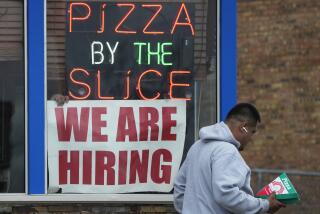Wages lag as U.S. payrolls grow
WASHINGTON — The U.S. finished its best year of job growth since 1999 with brisk hiring and a drop in unemployment last month, but there’s little indication that workers will start seeing wages go up much any time soon.
Employers, led by professional services and the construction industry, added a solid 252,000 net new jobs last month, the government said Friday. The report showed that the U.S. remains unfazed by weakness in the global economy, notably Europe and Japan.
The nation’s unemployment rate fell by a bigger-than-expected 0.2 percentage point to 5.6% in December, although that was largely because people left the labor force. The latest jobless figure is down from 6.7% a year earlier and the lowest since June 2008.
The American labor market and economy have gathered steam in recent months, aided by plunging energy prices that have boosted consumer spending. Friday’s report from the Labor Department buttressed analysts’ forecasts for healthy job gains this year.
“It looks like small-business owners are finally shaking off the effects of the recession,” said William Dunkelberg, chief economist for the National Federation of Independent Business. The number of those self-employed also has increased in recent months.
But the outlook for the average worker’s earnings, which have stagnated for years, is less optimistic. Despite the relatively low jobless rate, which some economists think signals an economy nearing full employment, there’s been little evidence thus far that wage pressures are building.
In December, average hourly earnings for all private-sector workers fell 5 cents to $24.57, almost reversing the 6-cent gain in November that had raised hopes of a long-anticipated sustained rise in pay. On average, last month’s hourly pay was up 1.7% from a year earlier, a tad above the inflation rate.
“I’m struggling,” said Chuck Suntalus, an acupuncturist and herbalist in El Monte, noting that he hasn’t had a raise in two years. Although he understands that his employer’s finances are tight, the 33-year-old said he may have no choice but to quit and start his own business.
The muted wage growth suggests that the unemployment rate is understating the weakness in the job market — that there is still a lot of slack in the economy, or supply of available workers waiting in the wings.
The amount of slack has been a major consideration in the Federal Reserve’s cautiousness about raising its benchmark interest rate, which has been pinned near zero since December 2008 to spur lending and investment through the recession and recovery.
Friday’s wage numbers strengthened Wall Street’s view that the Fed will not begin lifting the interest rate until its June meeting, at the earliest. Stocks fell on the jobs report in what has been a volatile week of trading.
Besides the lagging growth in earnings, December saw little improvement in the high share of long-term unemployed and workers stuck in part-time jobs.
What’s more, separate Labor Department figures show the quit rate of employees has stayed low, even as layoffs have receded sharply in recent months.
That’s a sign that workers remain wary about jumping to another company, which is typically how workers can get a big bump in pay.
“The winnowing of people at the middle levels has created downward wage pressure,” said Sean Scanlon, managing director of the Los Angeles branch of executive search firm DHR International. Those employees left are “willing to trade a little less base pay for stability, a positive work environment and the possibility of growth.”
William Spriggs, chief economist at the AFL-CIO in Washington, said labor unions have little bargaining leverage for larger wage increases, in part, because they’re focusing on retirement and health benefits.
“There’s no room for a lot of wage growth,” he said.
Although some economists think it may take as long as two years before wages move significantly, other experts see signs of broad-based pay gains much sooner, especially if job growth maintains its robust pace.
In its latest monthly survey of hundreds of company managers, the Society for Human Resource Management found a step-up in compensation for new hires, particularly in manufacturing.
Other surveys of workers, meanwhile, indicate that pay has replaced job security as the top concern, said Jen Schramm, manager of workforce trends at the society.
Vic Anselmo, who owns a metal-finishing shop in Oxnard, said he hasn’t felt the need to provide major raises to attract new workers.
After cutting his workforce nearly in half during the Great Recession, Anselmo’s business, Applied Powdercoat, has picked up over the last three years and he is now more comfortable about hiring. But he still relies in part on laborers from temporary agencies to fill shifts, giving him the flexibility to adjust his workforce if demand slows.
Anselmo has tried to boost wages where he can for full-time workers, giving strategic raises to experienced employees who are vital to the operation. But to keep getting business, he said he has to keep close tabs on costs.
“The slightest little increase affects how we do things,” he said. “If we go too high on prices, we don’t get the work and we go out of business.”
Employers in regions of the country with considerably lower unemployment — notably states in the Great Plains — are feeling more pressure to raise wages, as are those in certain trades such as plumbing and carpentry. Nationwide, the jobless rate in manufacturing was 3.9% in December.
Thanks partly to the plunge in oil prices, Jim Oostdyk’s auto tire and accessories business in New Jersey had his best year ever in 2014.
He has added three workers in the last year and is now up to 24 employees. And he is looking to fill three more openings in the coming months, two of them technicians. He said his full-time technicians earn on average $50,000 a year, up about 4% from a year ago.
Oostdyk, who started OK 4Wheel Drive in Stewartsville, about 60 miles west of Manhattan, right out of high school in 1979, reckons he’ll have to keep offering better pay and benefits to attract good workers.
“Ultimately, it’s a struggle finding good help,” he said. “Even with Jersey’s relatively high unemployment, it’s pretty difficult finding good staffing.”
More to Read
Inside the business of entertainment
The Wide Shot brings you news, analysis and insights on everything from streaming wars to production — and what it all means for the future.
You may occasionally receive promotional content from the Los Angeles Times.









